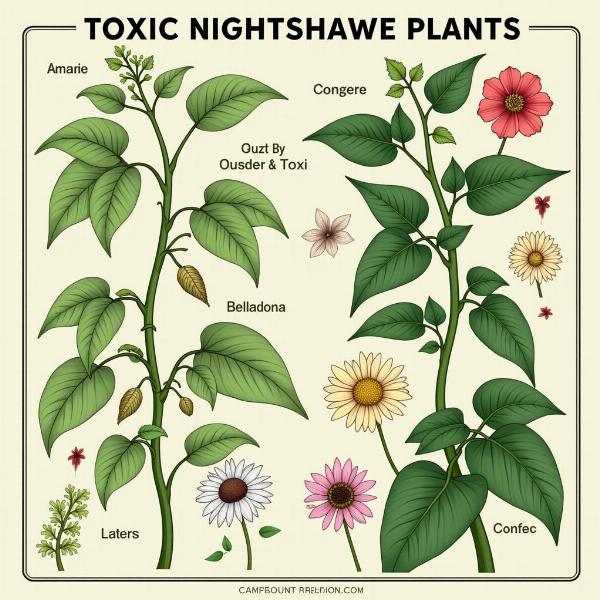Nightshade meaning in Hindi often revolves around the term “رات کی رانی” (raat ki rani) which translates to “queen of the night.” However, understanding the full meaning requires delving deeper into the various contexts, including botanical, culinary, and cultural aspects. This exploration will unravel the different interpretations and uses of the word “nightshade” within the Indian context.
Understanding the Term “Nightshade”
“Nightshade” isn’t a single plant but a family of plants known as Solanaceae. This family includes a diverse range of species, from common vegetables like tomatoes, potatoes, and eggplants to poisonous plants like belladonna. Therefore, simply translating “nightshade” to Hindi requires specifying which plant is being referred to. Are we discussing the edible varieties or the toxic ones? This distinction is crucial, especially in culinary and medicinal contexts.
Common Edible Nightshades in India
Many common vegetables in Indian cuisine belong to the nightshade family. These include:
- Tomato (टमाटर – tamatar): A staple in countless Indian dishes, providing a tangy base for curries and sauces.
- Potato (आलू – aaloo): A versatile vegetable used in various preparations, from fried snacks to hearty curries.
- Eggplant (बैंगन – baingan): Another popular vegetable, often roasted, fried, or used in curries.
- Chillies (मिर्च – mirch): An essential ingredient that adds spice and heat to Indian dishes.
These vegetables are widely consumed and form an integral part of the Indian diet.
Toxic Nightshades and Their Significance
While many nightshades are edible, some are highly toxic. Belladonna (Atropa belladonna), also known as deadly nightshade, is one such example. These poisonous plants are rarely used in culinary practices and are primarily known for their medicinal properties in traditional Ayurvedic medicine. However, their use requires careful handling and expert knowledge due to their potent nature.
 Toxic Nightshade Plants
Toxic Nightshade Plants
“Raat Ki Rani” and Its Cultural Connotations
“Raat ki rani” (रात की रानी) typically refers to the night-blooming jasmine (Cestrum nocturnum), which, although sharing the “night” aspect with some nightshades, is not a member of the Solanaceae family. Its fragrant blossoms release their scent at night, hence the name “queen of the night.” This phrase often carries romantic connotations in Hindi literature and poetry.
Nightshade Meaning in Hindi: A Culinary Perspective
In culinary discussions, “nightshade” in Hindi usually refers to the edible varieties, specifically tomatoes, potatoes, and eggplants. The term often isn’t directly used; instead, the specific vegetable name is employed. For example, one would say “tamatar ka achar” (tomato pickle) rather than “nightshade pickle.”
What are the health benefits of edible nightshades?
Edible nightshades offer various health benefits. Tomatoes are rich in lycopene, an antioxidant linked to reduced cancer risk. Potatoes provide potassium and vitamin C, while eggplants are a good source of fiber.
Are all nightshade vegetables safe to eat?
While most nightshade vegetables are safe for consumption, some individuals may experience sensitivities or allergies. It’s always best to consult with a healthcare professional if you have any concerns.
Conclusion
“Nightshade meaning in Hindi” encompasses various interpretations depending on the context. While “raat ki rani” can be associated with the idea of nightshade, it usually refers to a different plant altogether. Understanding the specific plant being referenced, whether edible or toxic, is crucial. From the culinary delights of tomatoes and potatoes to the medicinal potential of belladonna, the nightshade family plays a diverse role in Indian culture and cuisine.
FAQ
- What is the Hindi word for nightshade vegetables? There isn’t one single word. The specific vegetable names like “tamatar” (tomato), “aaloo” (potato), and “baingan” (eggplant) are used.
- Is “raat ki rani” a nightshade? No, “raat ki rani” typically refers to night-blooming jasmine, which is not a member of the nightshade family.
- Are nightshade vegetables harmful? Most are safe and nutritious, but some individuals may have sensitivities.
- What are the common uses of nightshades in India? Primarily culinary, with some toxic varieties used in traditional medicine.
- Where can I learn more about nightshade plants? Botanical gardens, online resources, and books on Indian flora can provide more information.
- What are the culinary applications of nightshade vegetables in India? They are used in curries, pickles, snacks, and many other dishes.
- What precautions should be taken when using toxic nightshades? Consult with an Ayurvedic practitioner for safe and appropriate usage.
Connect with Meaning-Hindi.in for Expert Hindi Translations
Meaning-Hindi.in is your trusted partner for accurate and culturally sensitive Hindi translation services. We specialize in various domains, including business, legal, technical, website localization, and academic translations. Our expertise ensures that your message is conveyed effectively and respectfully within the Indian context. Whether you need to translate documents, website content, or educational materials, our team of skilled linguists delivers high-quality translations tailored to your specific needs. Contact us today for a free quote!
Email: [email protected]
Phone: +91 11-4502-7584
Meaning-Hindi.in offers comprehensive language solutions to bridge the communication gap between Hindi and other languages.